Art World
‘It Was a Feat I Thought I Couldn’t Handle’: Artist Jacolby Satterwhite Dissects His New Video Collaboration With Musician Perfume Genius
The two teamed up on a project that is hypnotic, surreal, and symbiotic.
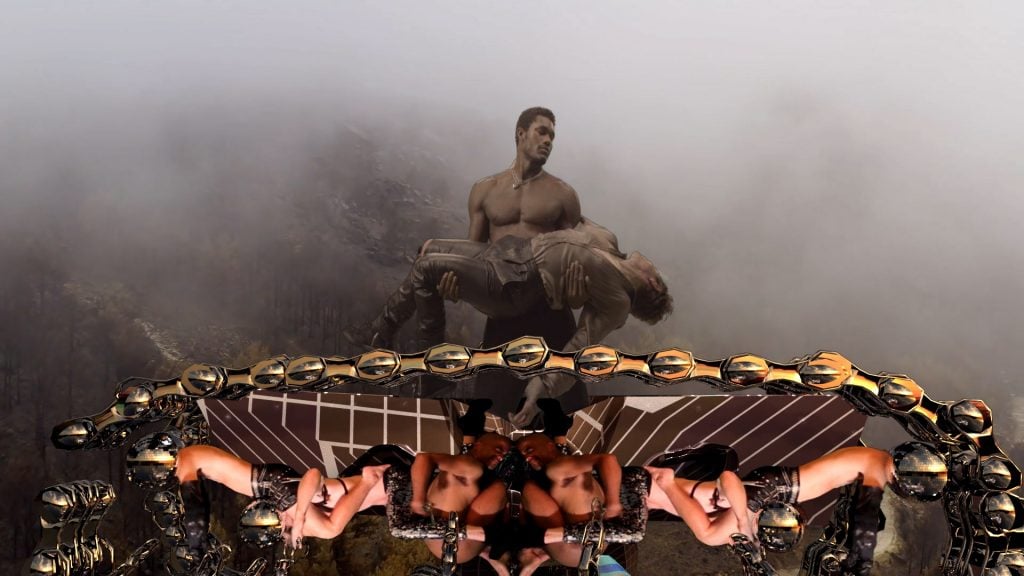
The two teamed up on a project that is hypnotic, surreal, and symbiotic.

William Van Meter

Earlier this month, the multimedia artist Jacolby Satterwhite was mingling at the Guggenheim Young Collectors Party. He’s perhaps best known for his maximalist 3D animations, and a preview of his latest video project was to be projected on the Frank Lloyd Wright-designed rotunda. He’d been doing final edits up until the event.
“It’s the biggest labor of love I’ve had by far,” he said. “The magnitude and dynamism in the piece was a feat that I thought I couldn’t handle.”
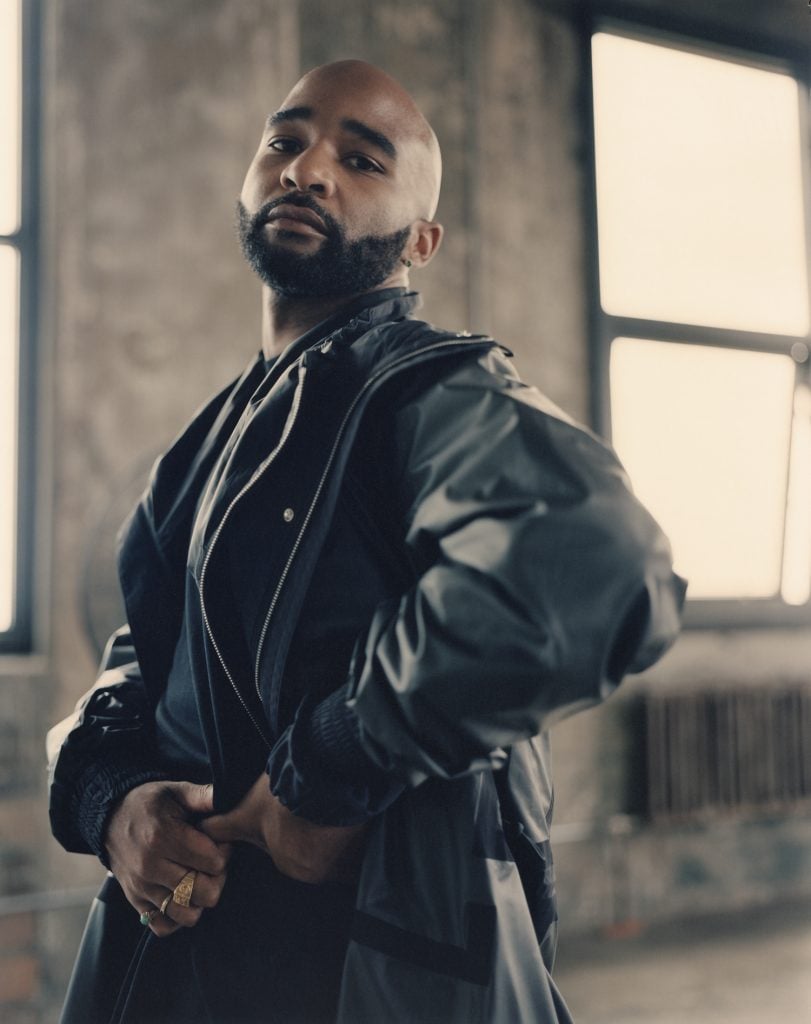
Jacolby Satterwhite has a maximalist vision. Photo by Andreas Laszlo Konrath.
Pygmalion’s Ugly Season is Satterwhite’s 27-minute symbiotic companion to Ugly Season, the just-released album by Mike Hadreas, who performs and records under the moniker Perfume Genius. The collaboration grew out of mutual fandom; after the two were introduced and embarked on a yearlong phone relationship, the project germinated organically.
The video features the artist, Hadreas, and an all-male coterie in a metaverse-modern dance recital. What begins as an animated queer fantasia segues into a live-action fire-escape throwdown. Far from MTV fodder, Satterwhite’s epic digital maelstrom pits crashing and careening utopian visions against a meditation on the human condition. As with his previous works, the video conjures a fever-dream universe that is as visually compelling as it is challenging to decipher.
“Jacolby taps into pure chaos,” says Hadreas. “There’s a million competing ideas about the future, and then there’s a lot about family, memory, and the past—all this stuff all at once. But in the end, it’s harmonious and elegant, even though there are so many elements.”
On June 1, the night of the Guggenheim party, Hadreas was in the basement dressing area. He seemed calm before his performance. The day had been auspicious. Earlier, the Yeah Yeah Yeahs released their first song in nearly a decade, “Spitting Off the Edge of the World,” for which he had supplied guest vocals and a video cameo. But Perfume Genius has moved well past traditional indie-rock stylings. For his sixth album, he traded pop hooks for a compellingly weird amalgam of ambient, soul, dub, electronics, and strings—the perfect experimental backdrop to inspire his collaborator.
“Jacolby’s animation and the way that he makes things is very physical and spiritual,” Hadreas noted.
Later that night, Satterwhite was beaming as his dreamscape illuminated the room. Party guests danced beneath a towering image of a shirtless man cradling Hadreas as lava churned around them.
Satterwhite took a break from adapting the video into a longer, two-channel installation for next month’s Front International: Cleveland Triennial for Contemporary Art (opening July 16) to chat about the Perfume Genius project and other endeavors.
Pygmalion’s Ugly Season is a huge undertaking. Where will it live beyond YouTube?
I actually don’t know. The concept of the piece is rooted to something I’ve been working on for two years, “Dawn,” a public commission and artwork I did in Cleveland. I spent the lockdown commissioning drawings from homeless people, teachers, students, and essential workers in this Black neighborhood.
I would exchange Amazon and Netflix gift cards [with the public] for drawings. The prompt was, “What is your prospect for utopia?” I got a range that represented different ideals and capitalism, whether it was city infrastructure or Cadillacs and Rolexes. Some were rooted in family and motherhood. Some were poetry, some were philosophy. Some were about nature and pets. I kind of turned this city into Pygmalion during their darkest hour. I had to mediate: What is utopia for them?
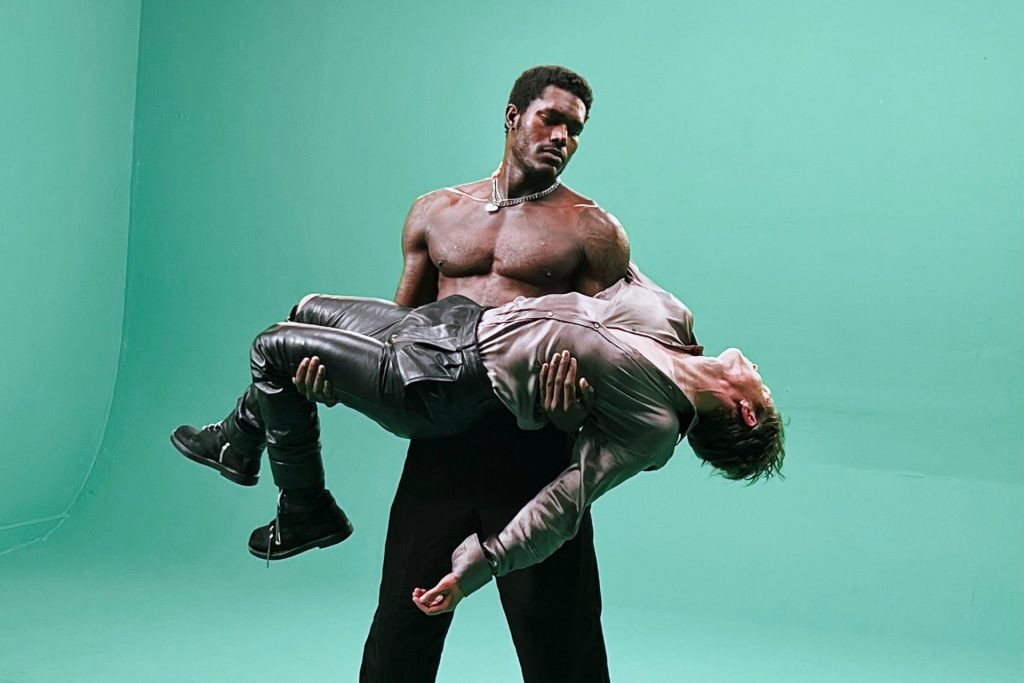
The dancer Boy Radio cradles Mike Hadreas of Perfume Genius during filming of Jacolby Satterwhite’s Pygmalion’s Ugly Season. Photo by Bryan Ling, courtesy of Matador.
I took these drawings and I traced them for half a year, and built all the wonky objects you see in that video. It relates to Perfume Genius because Ugly Season lyrically promotes and investigates the same ideas, about utopianism and finding a partner and a man and idealizing him so much that he is unachievable.
There are themes that thread throughout the album: songs about health, the human body, and healing. The album is existential, experimental, and atmospheric, and it coincided with what I was doing. Our friendship thrives on the synchronicity of where we were going conceptually. I thought it would be interesting if the narratives and lyrics of Ugly Season were put into this world that I built.
The film begins with you seated, almost nude, before your body fades into symbols.
You see maps on my chakras, basically dissecting my body. The camera zooms into each chakra, and you are basically going into different portals of capitalist desire. At the end of the video, they shape me back to being whole, returning me to the secular space.
Are all of the visuals in your work representational, or are some things purely aesthetic?
Everything I do has meaning and purpose. Well, formalism comes first. I’m a painter; I come from painting. You can’t really communicate without knowing what shape, color, line, space, and light can do to achieve meaning. I make things by myself. I’m working with lighting and rigging and rendering forms and coding things, so the gravitational liquids can fall on the surface in a convincing way. Or I’m working with the way a light system can make fog and atmosphere and dust appear on a body while you’re using the camera to create depth of field, and you have to use a certain kind of code to make the depth the field happen.
I wake up at 7:00 in the morning and I work from 8:30 or 9 at night, figuring out, “How do I make this come together like a Hieronymus Bosch or Peter Paul Rubens or a Modernist painting?” The biggest way to seduce and manipulate the viewer to enter your conceptual terrain is to be a master of color, light, and shape, and that’s my thing. I’m a colorist.
Your work also often relates to dance. Perfume Genius based this album after a dance project, and the two of you dance together in your collaboration. Can you tell us about the influence of dance?
Movement has been a large part of my practice for over a decade—originally it was because I had no one else to perform [in my videos]. I went to the University of Pennsylvania for my MFA after the Maryland Institute College of Art for undergrad. I studied painting, but started making video animation and experimental art after school. In a way, I entered it with a very back-door, experimental process. But I was a big art-history nerd and I have people I looked up to. My devices were regimented through late Modernist artists.
When it comes to dance, I was inspired by [the choreographers] Pina Bausch, William Forsythe, and Anne Teresa De Keersmaker—their Modernist movement styles and how they were able create interesting shapes compositionally for a still or a moving image. It felt like these movement styles were kind of object-oriented, and that allowed me to do my own on a green screen with composite objects on top. I can actually do interesting time-based narratives with image composites and 3D animations. It was sort of about composition and interactivity.
I sent Mike [Hadreas] hours of footage of my movement. When we came together in person, I gave choreographic gestures. My instructions were open-ended, but there was a structure, because I knew what I wanted to animate.
Language is restricting and language has limits. Movement is universal, and can also act as a Rorschach test that leads to more open-ended narrative-building. It allows me to delve into visual abstractions that are iterative and constantly inventive.
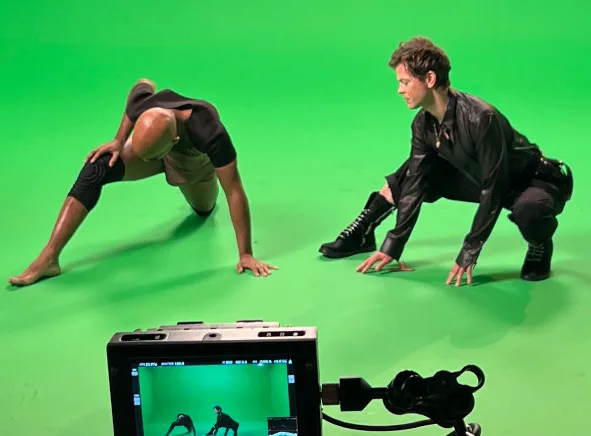
Behind the scenes of Pygmalion’s Ugly Season, with Jacolby Satterwhite and Perfume Genius. Courtesy of Matador.
It’s remarkable you did this project in such a short timeframe.
I was just wrapping up a painting show for MoMA PS1 and getting ready for my show at Lincoln Center. There was so much on my plate. We were shooting by February, while I was teaching at Yale and doing stuff at the University of California, Los Angeles.
But I squeezed in the time, and it was quite a muscular feat. I didn’t leave the house, except occasionally, and I was crazy. It was very painful, but it was rewarding. I love what I do. It makes me really happy. Even though I might have depression spells about it, or anxiety, nothing feels better than executing something that pushes you forward.
Anxiety and depression are often part of the creative process.
The key to happiness is to have a mixture of dystopianism and utopianism, because it’s so relative. You don’t understand light without having dark.
We all longed for utopia during the pandemic lockdowns. We needed escapism. It’s why nightclubbing is so great.
But even nightclubbing is dystopian, in some regards, the politics within nightlife. There’s lots of glee and there’s lots of transgression and self-destruction. It’s sort of like Dante’s Inferno: if the world was utopian, we wouldn’t have a happiness index.
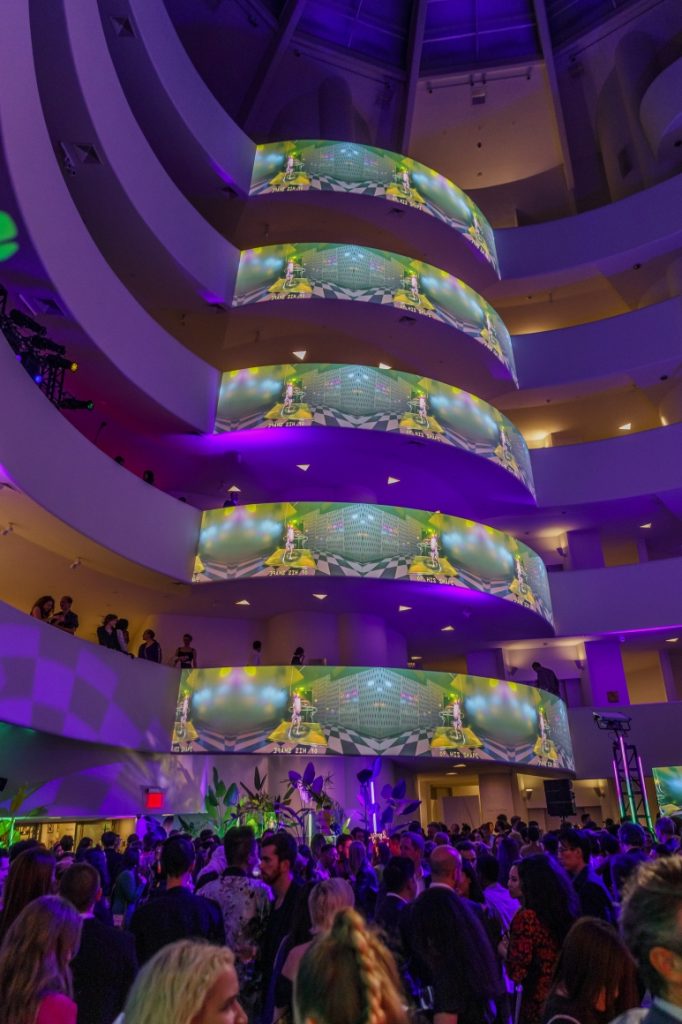
The Guggenheim’s rotunda became a screen for Satterwhite’s video. Courtesy of Matador.